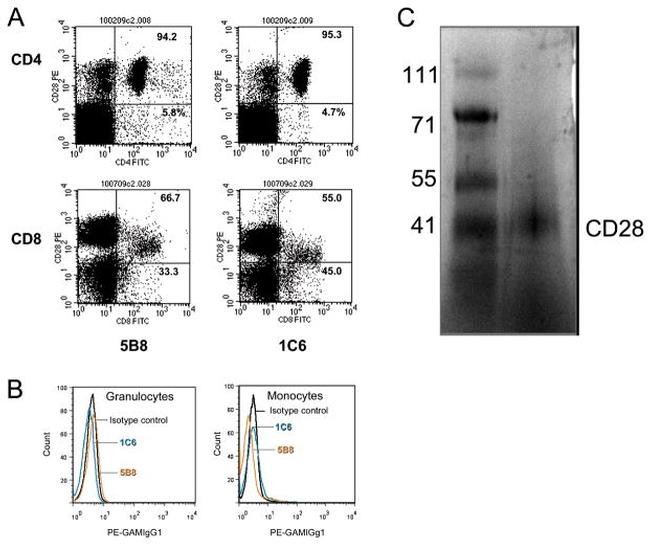Search Thermo Fisher Scientific
Invitrogen
CD28 Monoclonal Antibody (1C6), Functional Grade, eBioscience™
产品信息
16-0283-38
已发表种属
宿主/亚型
分类
类型
克隆号
偶联物
形式
浓度
保存条件
运输条件
RRID
产品详细信息
Description: The 1C6 monoclonal antibody reacts with canine CD28, which is expressed by thymocytes, a majority of T cells, and a subset of NK cells. CD28 is a ligand for CD80 (B7-1) and CD86 (B7-2) and is a potent costimulator of T cells. Signaling through CD28 augments IL-2 and IL-2 receptor expression as well as cytotoxicity of CD3-activated T cells.
The 1C6 antibody has been reported to have antagonist activity, as well as induce proliferation. The 1C6 and 5B8 antibodies recognize different epitopes of canine CD28.
Applications Reported: This 1C6 antibody has been reported for use in flow cytometric analysis and functional assays. Proliferation assays with the 1C6 antibody are best performed using polypropylene plates. (Fluorochrome-conjugated 5B8 is recommended for use in flow cytometry).
Applications Tested: This 1C6 antibody has been tested by flow cytometric analysis of normal canine peripheral blood cells. This can be used at less than or equal to 1 µg per test. A test is defined as the amount (µg) of antibody that will stain a cell sample in a final volume of 100 µL. Cell number should be determined empirically but can range from 10^5 to 10^8 cells/test. It is recommended that the antibody be carefully titrated for optimal performance in the assay of interest.
Storage and handling: Use in a sterile environment.
Filtration: 0.2 µm post-manufacturing filtered.
Purity: Greater than 90%, as determined by SDS-PAGE.
Endotoxin Level: Less than 0.001 ng/µg antibody, as determined by LAL assay.
Aggregation: Less than 10%, as determined by HPLC.
靶标信息
CD28 antigen is a 44 kDa disulfide linked homodimeric T cell specific surface glycoprotein. CD28 is a cell adhesion molecule of the immunoglobulin superfamily which is constitutively expressed on most peripheral blood T lymphocytes. Moreover, CD28 is the critical T cell costimulatory receptor that provides the cell the important second activation signal by binding CD80 and CD86 which are expressed by antigen presenting cells. In addition to its co-stimulation role, CD28 functions by preventing T cells from entering an anergic-hyporesponsive state or from undergoing premature apoptotic cell death. In murine peripheral lymphoid organs and in the blood, all CD4+ and CD8+ T cells express CD28. In the thymus, CD28 expression is highest on immature CD3-, CD8+ and CD4+8+ cells, and on CD4-8- cells that express alpha/beta and gamma/delta TCR. The level of CD28 on mature CD4+ and CD8+ alpha/beta TCR+ thymocytes is two- to fourfold lower than on the immature cells. Diseases associated with CD28 dysfunction include mycosis fungiodes and Sezary's Disease.
仅用于科研。不用于诊断过程。未经明确授权不得转售。




